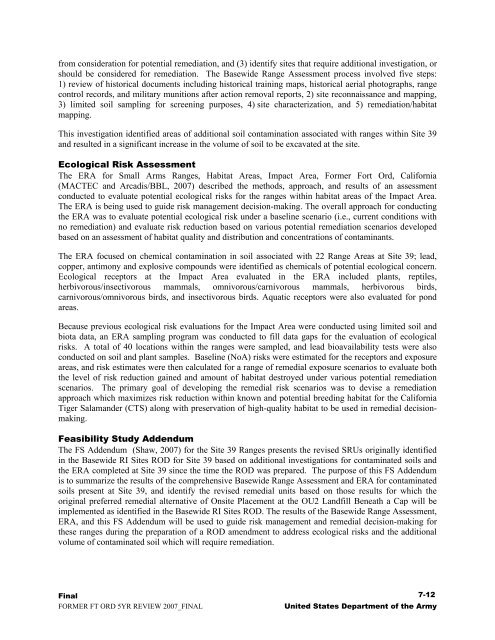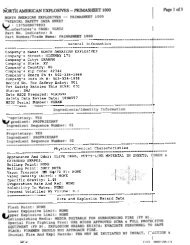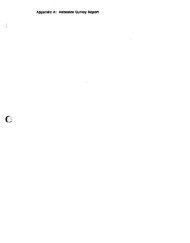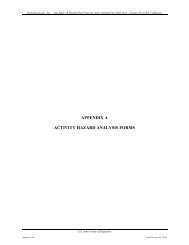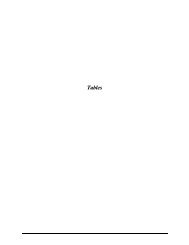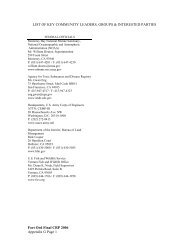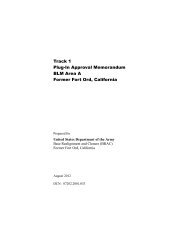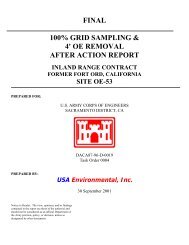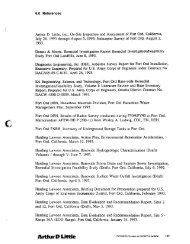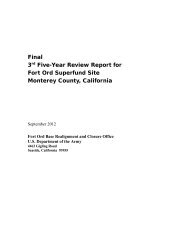Final Second Five-Year Review Report Fort Ord Superfund Site ...
Final Second Five-Year Review Report Fort Ord Superfund Site ...
Final Second Five-Year Review Report Fort Ord Superfund Site ...
You also want an ePaper? Increase the reach of your titles
YUMPU automatically turns print PDFs into web optimized ePapers that Google loves.
from consideration for potential remediation, and (3) identify sites that require additional investigation, or<br />
should be considered for remediation. The Basewide Range Assessment process involved five steps:<br />
1) review of historical documents including historical training maps, historical aerial photographs, range<br />
control records, and military munitions after action removal reports, 2) site reconnaissance and mapping,<br />
3) limited soil sampling for screening purposes, 4) site characterization, and 5) remediation/habitat<br />
mapping.<br />
This investigation identified areas of additional soil contamination associated with ranges within <strong>Site</strong> 39<br />
and resulted in a significant increase in the volume of soil to be excavated at the site.<br />
Ecological Risk Assessment<br />
The ERA for Small Arms Ranges, Habitat Areas, Impact Area, Former <strong>Fort</strong> <strong>Ord</strong>, California<br />
(MACTEC and Arcadis/BBL, 2007) described the methods, approach, and results of an assessment<br />
conducted to evaluate potential ecological risks for the ranges within habitat areas of the Impact Area.<br />
The ERA is being used to guide risk management decision-making. The overall approach for conducting<br />
the ERA was to evaluate potential ecological risk under a baseline scenario (i.e., current conditions with<br />
no remediation) and evaluate risk reduction based on various potential remediation scenarios developed<br />
based on an assessment of habitat quality and distribution and concentrations of contaminants.<br />
The ERA focused on chemical contamination in soil associated with 22 Range Areas at <strong>Site</strong> 39; lead,<br />
copper, antimony and explosive compounds were identified as chemicals of potential ecological concern.<br />
Ecological receptors at the Impact Area evaluated in the ERA included plants, reptiles,<br />
herbivorous/insectivorous mammals, omnivorous/carnivorous mammals, herbivorous birds,<br />
carnivorous/omnivorous birds, and insectivorous birds. Aquatic receptors were also evaluated for pond<br />
areas.<br />
Because previous ecological risk evaluations for the Impact Area were conducted using limited soil and<br />
biota data, an ERA sampling program was conducted to fill data gaps for the evaluation of ecological<br />
risks. A total of 40 locations within the ranges were sampled, and lead bioavailability tests were also<br />
conducted on soil and plant samples. Baseline (NoA) risks were estimated for the receptors and exposure<br />
areas, and risk estimates were then calculated for a range of remedial exposure scenarios to evaluate both<br />
the level of risk reduction gained and amount of habitat destroyed under various potential remediation<br />
scenarios. The primary goal of developing the remedial risk scenarios was to devise a remediation<br />
approach which maximizes risk reduction within known and potential breeding habitat for the California<br />
Tiger Salamander (CTS) along with preservation of high-quality habitat to be used in remedial decisionmaking.<br />
Feasibility Study Addendum<br />
The FS Addendum (Shaw, 2007) for the <strong>Site</strong> 39 Ranges presents the revised SRUs originally identified<br />
in the Basewide RI <strong>Site</strong>s ROD for <strong>Site</strong> 39 based on additional investigations for contaminated soils and<br />
the ERA completed at <strong>Site</strong> 39 since the time the ROD was prepared. The purpose of this FS Addendum<br />
is to summarize the results of the comprehensive Basewide Range Assessment and ERA for contaminated<br />
soils present at <strong>Site</strong> 39, and identify the revised remedial units based on those results for which the<br />
original preferred remedial alternative of Onsite Placement at the OU2 Landfill Beneath a Cap will be<br />
implemented as identified in the Basewide RI <strong>Site</strong>s ROD. The results of the Basewide Range Assessment,<br />
ERA, and this FS Addendum will be used to guide risk management and remedial decision-making for<br />
these ranges during the preparation of a ROD amendment to address ecological risks and the additional<br />
volume of contaminated soil which will require remediation.<br />
<strong>Final</strong><br />
7-12<br />
FORMER FT ORD 5YR REVIEW 2007_FINAL United States Department of the Army


